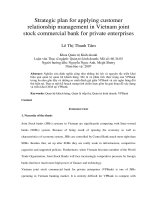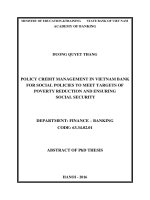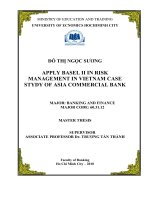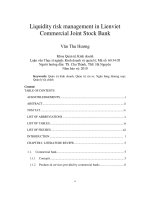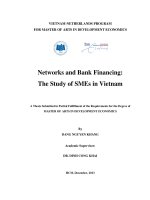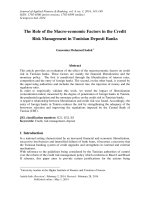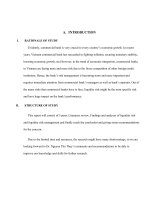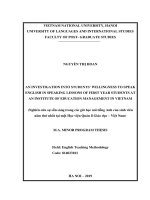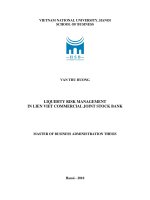bank risk management liquidity risk management in vietnam commercial banks
Bạn đang xem bản rút gọn của tài liệu. Xem và tải ngay bản đầy đủ của tài liệu tại đây (104.6 KB, 18 trang )
A. INTRODUCTION
I.
RATIONALE OF STUDY
Evidently, commercial bank is very crucial to every country’s economic growth. In recent
years, Vietnam commercial bank has succeeded in fighting inflation, securing monetary stability,
boosting economic growth, etc.However, in the trend of economic integration, commercial banks
in Vietnam are facing more and more risk due to the fierce competition of other foreign credit
institution. Hence, the bank’s risk management is becoming more and more important and
requires immediate attention from commercial bank’s managers as well as bank’s operator. Out of
the many risks that commercial banks have to face, liquidity risk might be the most specific risk
and have huge impact on the bank’s performance.
II.
STRUCTURE OF STUDY
This report will consist of 3 parts: Literature review, Findings and analyses of liquidity risk
and liquidity risk management and finally reach the conclusion and giving some recommendations
for the concern.
Due to the limited time and resources, the research might have many shortcomings, so we are
looking forward to Dr. Nguyen Thu Thuy’s comments and recommendations to be able to improve
our knowledge and skills for further research.
Principles of Banking
1
Group 2
B. LITERATURE REVIEW
I.
DEFINITION
For commercial banks, liquidity risk is very typical, the reason is that the vast majority of
bank capital is mobilized capital that can be withdrawn before maturity date. Liquidity risk
happens when the changes in secondary market become a problem for the transformation of the
bank’s asset into cash to meet financial demands and this can be caused by the increase in the cost
or time of the transactions. The loss that the bank has to suffer is the additional cost for finding
other sources of fund. If the bank cannot make immediate payments, it will lead to the decrease in
the number of depositors or even worse, bankruptcy. Lending is the primary investment activity of
the bank so as a financial intermediary, it needs to maintain its ability to make payment or in other
words, maintain its liquidity.
We would like to list some detailed examples of liquidity risk:
+ In the 1970s, the commercial banks in developed countries lended hundreds of billions
of dollars to developing countries. In the 1980s, those loans became insolvent. Debt crisis took
place in many countries, especially Latin America. Consequently, many of those banks were
unable to pay the depositors, suffered losses and then went out of business.
+ In the 1990s, Japanese securities firms were in a dilemma due to the collapse of realestate market and security market. The commercial banks that supplied funds for those firms
could not reclaim the loan and pay the depositors. During the same period, some credit unions
suffered losses and caused bank run, which led to continuous collapses
Principles of Banking
II.
2
Group 2
CHARACTERISTICS
Liquidity risk is the most typical risk faced by commercial banks. There are three main
reasons:
+ The capital the banks raise has high degree of liquidity. The main source of bank’s
capital is from call deposit. The withdrawal date and the amount to withdraw can be an obstacle in
banking’s management.
+ The bank’s asset usually has lower degree of liquidity than the bank’s liabilities. The
asset of the bank comes from loans. The quantity and due date are usually agreed and fixed in
credit contracts and it is very rare for the bank to receive the payment before the due date.
Moreover, if the customers are in need of capital and their projects are workable, the banks will
make loans. When an immediate demand for cash arises, the banks usually have to bid their asset.
The asset with higher liquidity often brings lower revenue and is rarely in the possession of banks.
Meanwhile, the banks do not want to bid the one with huge revenue due to difficulties in
transaction and exposure to high risk. In addition, the market for bank’s asset does not develop.
+ Banking activities is often based on credibility. Basically, all banks can offer the same
services. However, choices of banks to deposit or to take out a loan or to use payment services
rely much on their “name”. Hence, if there is any rumor which can hurt the bank’s reputation,
illiquidity risk is likely to happen.
III.
MEASUREMENT OF LIQUIDITY
The criteria to evaluate the liquidity risk comes from liquidity measurement. It include: Asset
liquidity rate, deposit liquidity rate, liquidity gap, and payment index.
Principles of Banking
a.
3
Group 2
Liquidity rate
These rates are used to compared the liquidity of current asset, short-term deposit & loan
and credit. The higher rate there is, the lower liquidity rate for commercial bank. There are many
indexes that the bank can use to evaluate its liquidity and liquidity risk
- Asset liquidity rate 1:
In which:
+ ALR 1: Asset liquidity rate.
+ TLA : Total liquidity assets.
+ TA : Total assets.
+ PR: Primary reserve .
+ SR: Secondary reserve.
How to determine which is the primary and which is the secondary reserve relies on the
financial situation and business ability of each bank and the regulation of every country. Normally,
TLA, PR, SR can be calculated by the following formulas:
In which:
+ C: Cash
Principles of Banking
4
+ DD1: Demand deposit 1
+ TD1: Term deposit 1
+ GSS : Government short-term securities
+ CSS: Convertible short-term securities
+ CL: Convertible loans
-
Asset liquidity rate 2:
Asset liquidity rate 2 is based on the the primary reserve of the bank
In which:
+ ALR: Asset liquidity rate
-
Deposit liquidity rate
This rate is based on the short-term deposit and borrowing of the bank
In which:
+ DLR : Deposit liquidity rate
+ SD: Short-term deposit
+ SB: Short-term borrowing
Group 2
Principles of Banking
5
Group 2
This rate reflects the liquidity rate of short-term deposit and borrowing.
-
Credit liquidity rate
In which:
+ CLR: Credit liquidity rate
+ O: Outstanding loan
This rate shows the liquidity per unit of credit that the bank provides.
b.
Liquidity gap
Liquidity gap shows the gap between the liquidity supply and liquidity demand. Negative
liquidity gap indicates liquidity risk.
Liquidity gap is calculated by a formula:
In which:
+ LG: Liquidity gap
+ LS: Liquidity supply
+ LD: Liquidity demand
Principles of Banking
6
Group 2
When Liquidity supply is higher than liquidity demand, which means that Liquidity gap is
positive, the bank has more cash than required therefore the bank is able to make payment and the
liquidity risk is quite low.
On the other hand, when the liquidity supply is lower than the Liquidity demand, Liquidity
gap is negative, the bank does not have enough cash to make payment and therefore, the liquidity
risk is very high.
Besides the above rates, banks can use other rate to evaluate its liquidity. Many banks estimate
the liquidity demand based on solely experience and the industry average ratio. So some other
rates can be used in liquidity management:
+ . The higher rate means that the bank has better ability in making immediate payment
+ . The higher this ratio, the lower the liquidity
IV.
LIQUIDITY RISK MANAGEMENT
a.
Management of liquidity demand
The liquidity demand includes:
Withdrawal on demand of the depositors, corporation or
organizations.
Credit demand of customer for online payment.
Loan payment when it is due.
Interest payment for deposit and loan
Principles of Banking
7
Group 2
The liquidity demand should be estimated beforehand based on some factors that can affect the
liquidity demand in short run and liquidity trend in long run.
b.
The rumor that can badly affect bank’s reputation.
Information about depositor’s income,savings and consumption
The policy and interest rates of other credit institutions.
The reputation of the bank itself.
Liquidity risk management by applying liquidity management theories.
- Commercial loan theory:
The commercial loan theory states that the liquidity of a bank can be maintained by
focusing on short-term self-liquidating productive loans to business organizations. Basically these
loans are working capital used to expedite the process of money making for those organizations.
Short-term productive loans mean higher debt recovery ability for debt collector because the
borrower always have stable income or revenue so there is little risk of bad debt.
However, the are some noticeable defects of this theory:
+ Short-term loan comes with lower interest rate which means lower revenue for banks
+ Undiversified loan maturity could threaten the customer’s loyalty as they can turn to
another bank for more diversified services. If all bank pursue the same rules, then it may reduce
the money supply, making it impossible for existing debtors to repay the debt at maturity
+ Do not consider the relative stability of bank deposit. This characteristic can allow
commercial bank to expand its capital for a long period of time without losing liquidity.
Principles of Banking
-
8
Group 2
Shiftability theory
The theory states that the liquidity of a bank can be maintained if the bank continue a
substantial amount of assets that can be moved to other banks for cash without any loss of
material. These assets can include: stock of company with good financial and business situation,
government bonds, good quality loan (Mortgage loan).
This theory has positive elements of truth and can motivate term lending by banks.
However, this theory fail to consider some other factors like the economic conditions or when
there is a run on the bank, etc.
-
Anticipated income theory:
The liquidity of a bank is not only measured by the transformation of its asset. After many
analysis of the bank liquidity on the viewpoint of cash flow, it is concluded that the repayment of
the borrower does not occur when the debt matures but rather during the entire time of borrowing.
The medium or long term loan often comes with a mortgage from a customer and the mortgage
will be used and depreciated. If the borrowers borrow money for long-term good, the loan should
be repaid by the future earnings of the borrower in installments rather giving lump sum at the
maturity of the loan in order to increase the liquidity of the asset.
This theory did not deny the commercial loan theory or the shiftability theory but
emphasize on the potential of receiving debt payment with the borrower’s income rather than
relying solely on the mortgage. The theory does not affect how the bank wants to invest and
prevents the banking from having to face with the question of how to deal with the mortgage it is
holding. Overall, it significantly increase the liquidity of the bank.
Principles of Banking
-
9
Group 2
The liabilities management theory:
This theory was formed in the mid-1960s of the 20th century, attached to the formation of
a new mobilization tool, the certificate of deposit and the CD market. In addition to the traditional
borrowing of central banks and other commercial banks, the CD allows large central banks to
mobilize large amounts of capital at a short time, at a cheaper cost. issuing medium and long term
bonds. In addition, the development of an international and regional interbank market allows
banks around the world to borrow from one another on a large scale, with low transaction costs
and less affected by the policy of Central bank of each country. This operating environment
increases the ability of commercial banks to borrow. According to the authors, if a bank has a high
ability to borrow, its liquidity is also high. Bank managers can maintain a portfolio of assets that
are more profitable than liquidity and use new deposits as the main method to meet liquidity
needs.
Principles of Banking
10
Group 2
C. FINDINGS AND ANALYSES
I.
OVERVIEW OF ASIA COMMERCIAL BANK (ACB)
Asia Commercial Joint Stock Bank (ACB) was established on 19 May 1993 and began
operations in June 1993. From that time, ACB has experienced a rapid rise and achieved many
milestones. ACB was actually the first bank in Vietnam to issue Mastercard and Visa international
debit card. In 1997, ACB implemented a two-year training program on banking operations
conducted by foreign bankers and banking specialists, to make sure that the bank was wellequipped. It also signed an agreement with the premier UK financial institution Standard
Chartered Bank to receive comprehensive technical assistance. The bank has also been awarded
two Labor Medals by the Vietnamese government (in 2006 and in 2008), as well as being
recognised by several prestigious institutions as a fine financial institution in Vietnam.
The Bank provides consumer and corporate commercial banking services, including deposits,
corporate and consumer lending, as well as trade financing. It is also involved in capital and
money markets at interbank level, along with treasury activities, commodities financing and
international clearing and settlement. Through its subsidiaries and affiliates, the Bank provides
investment banking services, such as securities brokerage, custody and underwriting services,
along with corporate advisory services. Other activities include gold bar manufacturing and asset
management.
II.
ASIA COMMERCIAL JOINT STOCK BANK (ACB)’S CASE OF LIQUIDITY RISK
In early 2003, ACB was still in effective business. The profit in the first 9 months of 2003 of
this bank increased by 20% compared to that of the same period in 2002 (reaching approximately
Principles of Banking
11
Group 2
170 billion) .ACB was very popular and trusted by domestic customers and foreign ones trust
when they deposit money. Therefore, the rumor of "General Director of ACB, Pham Van Thiet
escaped" caused a "shock" to people in Ho Chi Minh City, especially those who are depositors in
the bank. Here are some key developments of the incident:
- At the beginning of October 2003, the first rumor about the General Director of ACB began
to flee.
- About a week later, on Sunday (October 12) and Monday (October 13), the rumor became
widespread among people in Ho Chi Minh City.
- On October 14, 2003, the tension reached its "peak" when thousands of people rushed to
withdraw their money at the headquarters of ACB on Nguyen Thi Minh Khai Street and its branch
at 30 Mac Dinh Chi ( District 1 - Ho Chi Minh City). At these two locations, the population was
so crowded that it flooded the road,causing heavy traffic congestion hours. Thankfully, the
appearance in front of a large number of people of the State Bank of Vietnam Governor Le Duc
Thuy beside the General Director Pham Van Thiet and representatives of the City Government
was the most powerful rejection of rumor.
- Over the next day, October 15, despite the fact that great withdrawal continued, the press
agencies together with the individuals and authorities simultaneously had news and articles with a
view to rejecting the false information. Therefore by the end of the day, the situation calmed
down. Customers started to send deposits back to ACB. On October 16, the incident was almost
eliminated.
Principles of Banking
12
Group 2
- After a week, everything was back to normal. ACB restored all activities. Even at that time,
the number of depositors was much greater than that before the incident.
It can be seen that the reason for placing ACB in the context of liquidity risk in this case stems
from an external reason which is a “false rumor” (CEO of ACB fled) that led to a massive
withdrawal of money. This makes it difficult for banks to use market instruments to regulate bank
liquidity effectively.
This incident only happens in a very short time (about 3 days) but it is extremely serious.
Without the positive, synchronized and reasonable measures, the risk of a domino effect in the
whole banking industry (people will withdraw money at all banks) would have been totally
possible. At that time, the consequences would be hard to imagine.
On August 21, 2012, Vietnam financial market in general and Asia Commercial Bank (ACB)
in particular were unprecedentedly shocked by the news that "Bau" Kien - Nguyen Duc Kien, the
former Vice Chairman of the Association. Co-founder of ACB had been arrested for investigation
of economic misconduct.
The serious impact of this incident was immediately shown. Within just 3 days, 5.6 billion
USD of the capitalization of Vietnam stock market evaporated, not to mention the series of
declining sessions that followed. Trillions of VND was withdrawn from ACB in just a few days.
The wind and waves struck ACB continuously. Three days after Bau Kien was arrested, Mr.
Ly Xuan Hai - the former General Director of ACB was also arrested.
Below is analysis of financial indicators:
Principles of Banking
13
Group 2
Index
Quarter 3rd, 2013
Quarter 3rd, 2012
H3
6%
22%
In the third quarter of 2013, cash accounted for a very small proportion, which proved that the
bank did not have enough cash to meet the immediate liquidity demand, this index was lower than
10% so if there was a large and unexpected need for liquidity, the bank would certainly have to
borrow in the money market with high interest rates. The fact that proves this claim is that in 2012
Kien was arrested and in 2013, the bank had to resolve issues related to “Bau Kien”.
Index
Quarter 3rd, 2013
Quarter 3rd, 2012
H4
92%
96%
As we are concerned, credit is considered to be a low liquidity asset, but credit balance
accounted for over 90% of total assets, indicating that banks were quite illiquid. There was a
downward trend with very small degree, which showed that the risk of liquidity risk was not much
reduced.
Index
Quarter 3rd, 2013
Quarter 3rd, 2012
Principles of Banking
H6
14
18%
Group 2
11%
From the above data, we see that ACB bank actively held a number of securities to ensure its
liquidity, thereby showing that the bank was creating its liquidity but not much. .
Index
Quarter 3rd, 2013
Quarter 3rd, 2012
H8
7%
38%
Through analyses, we can see that in 2013, ACB was no longer in the safe range (<10%), there
was a significant decrease compared to 2012. Thus, the liquidity of ACB bank was being lost. One
of the reasons was that “Bau Kien” was arrested leading to the worse situation of bad debt.
Principles of Banking
15
Group 2
D. CONCLUSION AND RECOMMENDATIONS
The research managing liquidity risk, case study about ACB and a lot of problems in reality
have helped us have clear understandings about the reality of this risk. There can be a lot of
reasons that cause commercial banks to liquidity risk; for example, customers no longer believe in
commercial banks’ systems, the interference of Central Bank, etc. Liquidity risk is always
resonant and interactive.
Monetary authorities should be sure that Financial Institutions strictly follow the ratios to
avoid the occurrence of the liquidity risk. Commercial Banks should place an effective liquidity
risk management policies. Commercial Banks also should analyze the behavioral maturity of
varios components of balance sheets, financial statements, such as liquidity ratio. It would be
helpful if Commercial Banks evolve a system for monitoring high value deposits. Because the
liquidity risk also depends on the market conditions, Commercial Banks should evaluate liquidity
profile under different conditions
The conclusion and the recommendations above were made through this assignment after
researching and analyzing. However, we should know more aabout related topics, so that we can
have clearer understanding about liquidity risk management in Commercial Banks, especially
Vietnam Commercial Banks.
Principles of Banking
16
Group 2
E. REFERENCES
1.
John Manning (2017), Asia Commercial Bank: Reclaiming its position as one of Vietnam’s top
banks. Available from: />
2.
position-one-vietnams-top-banks/
Meghana S, Top 4 Theories of Liquidity Management. Available from:
/>
management/1234
3. David R. Harper (2019), Understanding Liquidity Risk. Available from:
/>4. Nam Quốc (2019), Chỉ số thanh khoản là gì?. Available from: />
khoan-la-gi~46448
Michael McCaw (2017), What are the objectives of liquidity management?. Available from:
/>6. Aboli Gangreddiwar (2015), 8 Risks in the Banking Industry Faced by Every Bank. Available
from: />
Principles of Banking
17
Group 2
Group Assessment Form
Group: 2
Class: NHAE302.1
Topic: BANK RISK MANAGEMENT: LIQUIDITY RISK
MANAGEMENT IN VIETNAM COMMERCIAL BANKS
Assessing the contribution to the presentation of each
Goo
Poor Fair Average
member in your group
Đỗ Ngọc Khánh
Lê Gia Khánh
Trần Hồng Đức
Đào Quỳnh Mai
Ohara Yuki
Excellent
d
x
x
x
x
x
